
(…) this making and unmaking of meaning (…) slides from a critique of meaning-making in art at large down towards the artist's particular affinity with art's poetic dimension (…) the panels appear to mark both the institution's various functions as a hybrid cultural centre that caters to various activities, disciplines and audiences, and, I would argue, more generally the place of art in society at large today, where it is increasingly forced into registers of efficiency, consumerist decor and fragmentary work ethics. (…) The tilting of the acoustic panels (…) sets out to place particular (…) italics (…) as you try to adjust your orientation to untilt the panel back to its imagined horizontality, you will find that now not the panel is tilted, but your head, neck and the perspective of the world around you (…) ghostly stillness (…)
—Timo Demollin, 2024
—Timo Demollin, 2024

(…) this making and unmaking of meaning (…) slides from a critique of meaning-making in art at large down towards the artist's particular affinity with art's poetic dimension (…) the panels appear to mark both the institution's various functions as a hybrid cultural centre that caters to various activities, disciplines and audiences, and, I would argue, more generally the place of art in society at large today, where it is increasingly forced into registers of efficiency, consumerist decor and fragmentary work ethics. (…) The tilting of the acoustic panels (…) sets out to place particular (…) italics (…) as you try to adjust your orientation to untilt the panel back to its imagined horizontality, you will find that now not the panel is tilted, but your head, neck and the perspective of the world around you (…) ghostly stillness (…)
—Timo Demollin, 2024
—Timo Demollin, 2024

(…) this making and unmaking of meaning (…) slides from a critique of meaning-making in art at large down towards the artist's particular affinity with art's poetic dimension (…) the panels appear to mark both the institution's various functions as a hybrid cultural centre that caters to various activities, disciplines and audiences, and, I would argue, more generally the place of art in society at large today, where it is increasingly forced into registers of efficiency, consumerist decor and fragmentary work ethics. (…) The tilting of the acoustic panels (…) sets out to place particular (…) italics (…) as you try to adjust your orientation to untilt the panel back to its imagined horizontality, you will find that now not the panel is tilted, but your head, neck and the perspective of the world around you (…) ghostly stillness (…)
—Timo Demollin, 2024
—Timo Demollin, 2024
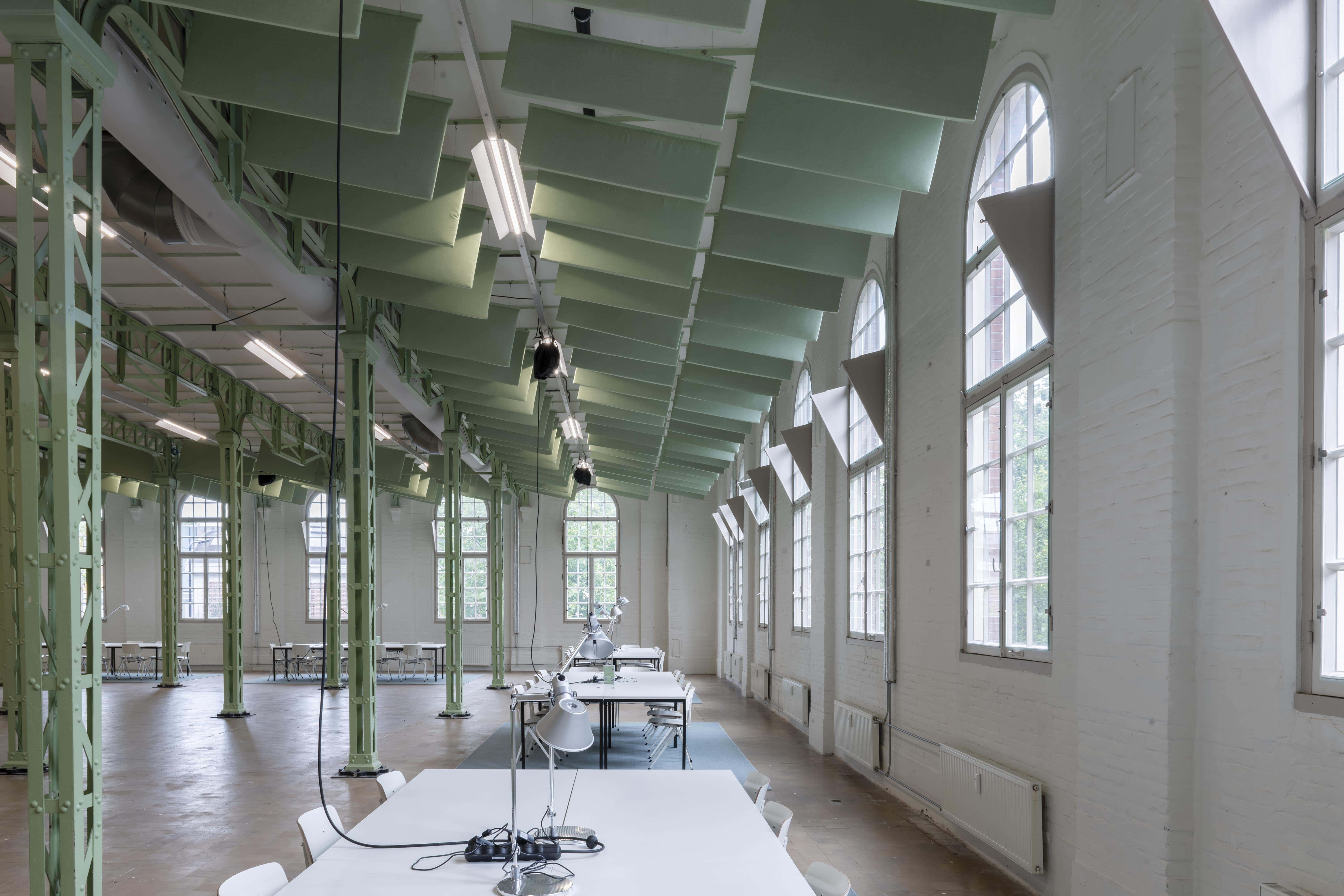
(…) this making and unmaking of meaning (…) slides from a critique of meaning-making in art at large down towards the artist's particular affinity with art's poetic dimension (…) the panels appear to mark both the institution's various functions as a hybrid cultural centre that caters to various activities, disciplines and audiences, and, I would argue, more generally the place of art in society at large today, where it is increasingly forced into registers of efficiency, consumerist decor and fragmentary work ethics. (…) The tilting of the acoustic panels (…) sets out to place particular (…) italics (…) as you try to adjust your orientation to untilt the panel back to its imagined horizontality, you will find that now not the panel is tilted, but your head, neck and the perspective of the world around you (…) ghostly stillness (…)
—Timo Demollin, 2024
—Timo Demollin, 2024

(…) this making and unmaking of meaning (…) slides from a critique of meaning-making in art at large down towards the artist's particular affinity with art's poetic dimension (…) the panels appear to mark both the institution's various functions as a hybrid cultural centre that caters to various activities, disciplines and audiences, and, I would argue, more generally the place of art in society at large today, where it is increasingly forced into registers of efficiency, consumerist decor and fragmentary work ethics. (…) The tilting of the acoustic panels (…) sets out to place particular (…) italics (…) as you try to adjust your orientation to untilt the panel back to its imagined horizontality, you will find that now not the panel is tilted, but your head, neck and the perspective of the world around you (…) ghostly stillness (…)
—Timo Demollin, 2024
—Timo Demollin, 2024

(…) this making and unmaking of meaning (…) slides from a critique of meaning-making in art at large down towards the artist's particular affinity with art's poetic dimension (…) the panels appear to mark both the institution's various functions as a hybrid cultural centre that caters to various activities, disciplines and audiences, and, I would argue, more generally the place of art in society at large today, where it is increasingly forced into registers of efficiency, consumerist decor and fragmentary work ethics. (…) The tilting of the acoustic panels (…) sets out to place particular (…) italics (…) as you try to adjust your orientation to untilt the panel back to its imagined horizontality, you will find that now not the panel is tilted, but your head, neck and the perspective of the world around you (…) ghostly stillness (…)
—Timo Demollin, 2024
—Timo Demollin, 2024

(…) this making and unmaking of meaning (…) slides from a critique of meaning-making in art at large down towards the artist's particular affinity with art's poetic dimension (…) the panels appear to mark both the institution's various functions as a hybrid cultural centre that caters to various activities, disciplines and audiences, and, I would argue, more generally the place of art in society at large today, where it is increasingly forced into registers of efficiency, consumerist decor and fragmentary work ethics. (…) The tilting of the acoustic panels (…) sets out to place particular (…) italics (…) as you try to adjust your orientation to untilt the panel back to its imagined horizontality, you will find that now not the panel is tilted, but your head, neck and the perspective of the world around you (…) ghostly stillness (…)
—Timo Demollin, 2024
—Timo Demollin, 2024

(…) this making and unmaking of meaning (…) slides from a critique of meaning-making in art at large down towards the artist's particular affinity with art's poetic dimension (…) the panels appear to mark both the institution's various functions as a hybrid cultural centre that caters to various activities, disciplines and audiences, and, I would argue, more generally the place of art in society at large today, where it is increasingly forced into registers of efficiency, consumerist decor and fragmentary work ethics. (…) The tilting of the acoustic panels (…) sets out to place particular (…) italics (…) as you try to adjust your orientation to untilt the panel back to its imagined horizontality, you will find that now not the panel is tilted, but your head, neck and the perspective of the world around you (…) ghostly stillness (…)
—Timo Demollin, 2024
—Timo Demollin, 2024

(…) this making and unmaking of meaning (…) slides from a critique of meaning-making in art at large down towards the artist's particular affinity with art's poetic dimension (…) the panels appear to mark both the institution's various functions as a hybrid cultural centre that caters to various activities, disciplines and audiences, and, I would argue, more generally the place of art in society at large today, where it is increasingly forced into registers of efficiency, consumerist decor and fragmentary work ethics. (…) The tilting of the acoustic panels (…) sets out to place particular (…) italics (…) as you try to adjust your orientation to untilt the panel back to its imagined horizontality, you will find that now not the panel is tilted, but your head, neck and the perspective of the world around you (…) ghostly stillness (…)
—Timo Demollin, 2024
—Timo Demollin, 2024

(…) this making and unmaking of meaning (…) slides from a critique of meaning-making in art at large down towards the artist's particular affinity with art's poetic dimension (…) the panels appear to mark both the institution's various functions as a hybrid cultural centre that caters to various activities, disciplines and audiences, and, I would argue, more generally the place of art in society at large today, where it is increasingly forced into registers of efficiency, consumerist decor and fragmentary work ethics. (…) The tilting of the acoustic panels (…) sets out to place particular (…) italics (…) as you try to adjust your orientation to untilt the panel back to its imagined horizontality, you will find that now not the panel is tilted, but your head, neck and the perspective of the world around you (…) ghostly stillness (…)
—Timo Demollin, 2024
—Timo Demollin, 2024

(…) this making and unmaking of meaning (…) slides from a critique of meaning-making in art at large down towards the artist's particular affinity with art's poetic dimension (…) the panels appear to mark both the institution's various functions as a hybrid cultural centre that caters to various activities, disciplines and audiences, and, I would argue, more generally the place of art in society at large today, where it is increasingly forced into registers of efficiency, consumerist decor and fragmentary work ethics. (…) The tilting of the acoustic panels (…) sets out to place particular (…) italics (…) as you try to adjust your orientation to untilt the panel back to its imagined horizontality, you will find that now not the panel is tilted, but your head, neck and the perspective of the world around you (…) ghostly stillness (…)
—Timo Demollin, 2024
—Timo Demollin, 2024
In Obliques
acoustic ceiling panels tilted 14 degrees
2024
dimensions variable

(…) a decidedly critical look at the exhibition's methodology and the artistic intervention it entails by developing it further. While the curatorial team decided for aesthetic and pragmatic reasons to leave out the window front and the ceiling (…) in the models, he had these missing spatial elements manufactured by the curatorial team for his work isn't here is here.
—Anna Marckwald, 2024
—Anna Marckwald, 2024

(…) a decidedly critical look at the exhibition's methodology and the artistic intervention it entails by developing it further. While the curatorial team decided for aesthetic and pragmatic reasons to leave out the window front and the ceiling (…) in the models, he had these missing spatial elements manufactured by the curatorial team for his work isn't here is here.
—Anna Marckwald, 2024
—Anna Marckwald, 2024

(…) a decidedly critical look at the exhibition's methodology and the artistic intervention it entails by developing it further. While the curatorial team decided for aesthetic and pragmatic reasons to leave out the window front and the ceiling (…) in the models, he had these missing spatial elements manufactured by the curatorial team for his work isn't here is here.
—Anna Marckwald, 2024
—Anna Marckwald, 2024
isn't here is here
wood, plexiglass, paint, glue
2024
55 x 55 x 28,3 cm

(…) sixteen curatorial and critical texts, written (…) in response to Vrancken's work, are used as material for sixteen erasures. (…) electrifies a network of relations: between the artist (…) the writer (…) the curator (…) the work (…) the text, and so on, leaving all of these parties feeling slightly off-kilter. And while, at first, this process may strike one as a mere exercise in turning tables—a voltage change in a closed circuit—it ultimately shapes the conditions for public reception. (…) an unconventional 'companion reader' to Vrancken's works—the great absentees of the book, evoked only by the epigraph 'Works 2016-2023'—in that each poem has one of Vrancken's pieces as its counterpart. (…) a commentary on institutional ventriloquism (…) Tellingly, Vrancken chose this image of dyeing, as if erasing, an element of the body, transforming a barrier into an opening. A hole within the hole in the well where words resonate doubly.
—Alicja Melzacka, 2024
—Alicja Melzacka, 2024

(…) sixteen curatorial and critical texts, written (…) in response to Vrancken's work, are used as material for sixteen erasures. (…) electrifies a network of relations: between the artist (…) the writer (…) the curator (…) the work (…) the text, and so on, leaving all of these parties feeling slightly off-kilter. And while, at first, this process may strike one as a mere exercise in turning tables—a voltage change in a closed circuit—it ultimately shapes the conditions for public reception. (…) an unconventional 'companion reader' to Vrancken's works—the great absentees of the book, evoked only by the epigraph 'Works 2016-2023'—in that each poem has one of Vrancken's pieces as its counterpart. (…) a commentary on institutional ventriloquism (…) Tellingly, Vrancken chose this image of dyeing, as if erasing, an element of the body, transforming a barrier into an opening. A hole within the hole in the well where words resonate doubly.
—Alicja Melzacka, 2024
—Alicja Melzacka, 2024

(…) sixteen curatorial and critical texts, written (…) in response to Vrancken's work, are used as material for sixteen erasures. (…) electrifies a network of relations: between the artist (…) the writer (…) the curator (…) the work (…) the text, and so on, leaving all of these parties feeling slightly off-kilter. And while, at first, this process may strike one as a mere exercise in turning tables—a voltage change in a closed circuit—it ultimately shapes the conditions for public reception. (…) an unconventional 'companion reader' to Vrancken's works—the great absentees of the book, evoked only by the epigraph 'Works 2016-2023'—in that each poem has one of Vrancken's pieces as its counterpart. (…) a commentary on institutional ventriloquism (…) Tellingly, Vrancken chose this image of dyeing, as if erasing, an element of the body, transforming a barrier into an opening. A hole within the hole in the well where words resonate doubly.
—Alicja Melzacka, 2024
—Alicja Melzacka, 2024

(…) sixteen curatorial and critical texts, written (…) in response to Vrancken's work, are used as material for sixteen erasures. (…) electrifies a network of relations: between the artist (…) the writer (…) the curator (…) the work (…) the text, and so on, leaving all of these parties feeling slightly off-kilter. And while, at first, this process may strike one as a mere exercise in turning tables—a voltage change in a closed circuit—it ultimately shapes the conditions for public reception. (…) an unconventional 'companion reader' to Vrancken's works—the great absentees of the book, evoked only by the epigraph 'Works 2016-2023'—in that each poem has one of Vrancken's pieces as its counterpart. (…) a commentary on institutional ventriloquism (…) Tellingly, Vrancken chose this image of dyeing, as if erasing, an element of the body, transforming a barrier into an opening. A hole within the hole in the well where words resonate doubly.
—Alicja Melzacka, 2024
—Alicja Melzacka, 2024

(…) sixteen curatorial and critical texts, written (…) in response to Vrancken's work, are used as material for sixteen erasures. (…) electrifies a network of relations: between the artist (…) the writer (…) the curator (…) the work (…) the text, and so on, leaving all of these parties feeling slightly off-kilter. And while, at first, this process may strike one as a mere exercise in turning tables—a voltage change in a closed circuit—it ultimately shapes the conditions for public reception. (…) an unconventional 'companion reader' to Vrancken's works—the great absentees of the book, evoked only by the epigraph 'Works 2016-2023'—in that each poem has one of Vrancken's pieces as its counterpart. (…) a commentary on institutional ventriloquism (…) Tellingly, Vrancken chose this image of dyeing, as if erasing, an element of the body, transforming a barrier into an opening. A hole within the hole in the well where words resonate doubly.
—Alicja Melzacka, 2024
—Alicja Melzacka, 2024

(…) sixteen curatorial and critical texts, written (…) in response to Vrancken's work, are used as material for sixteen erasures. (…) electrifies a network of relations: between the artist (…) the writer (…) the curator (…) the work (…) the text, and so on, leaving all of these parties feeling slightly off-kilter. And while, at first, this process may strike one as a mere exercise in turning tables—a voltage change in a closed circuit—it ultimately shapes the conditions for public reception. (…) an unconventional 'companion reader' to Vrancken's works—the great absentees of the book, evoked only by the epigraph 'Works 2016-2023'—in that each poem has one of Vrancken's pieces as its counterpart. (…) a commentary on institutional ventriloquism (…) Tellingly, Vrancken chose this image of dyeing, as if erasing, an element of the body, transforming a barrier into an opening. A hole within the hole in the well where words resonate doubly.
—Alicja Melzacka, 2024
—Alicja Melzacka, 2024

(…) sixteen curatorial and critical texts, written (…) in response to Vrancken's work, are used as material for sixteen erasures. (…) electrifies a network of relations: between the artist (…) the writer (…) the curator (…) the work (…) the text, and so on, leaving all of these parties feeling slightly off-kilter. And while, at first, this process may strike one as a mere exercise in turning tables—a voltage change in a closed circuit—it ultimately shapes the conditions for public reception. (…) an unconventional 'companion reader' to Vrancken's works—the great absentees of the book, evoked only by the epigraph 'Works 2016-2023'—in that each poem has one of Vrancken's pieces as its counterpart. (…) a commentary on institutional ventriloquism (…) Tellingly, Vrancken chose this image of dyeing, as if erasing, an element of the body, transforming a barrier into an opening. A hole within the hole in the well where words resonate doubly.
—Alicja Melzacka, 2024
—Alicja Melzacka, 2024
Teeth Surrounding a Flower in the Meanings
artist book
2023
29,7 x 21 cm, 98 pages (b/w ill.)
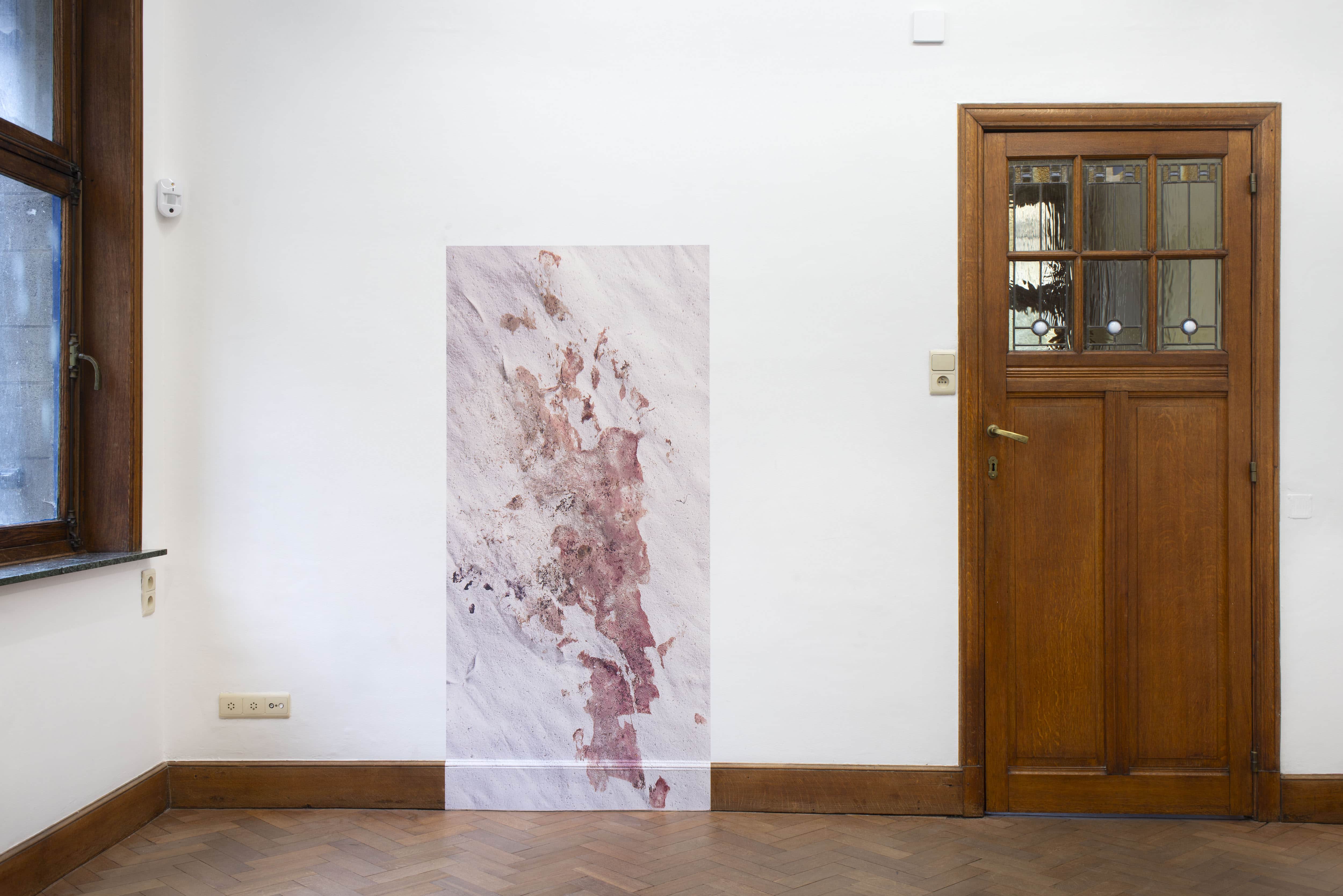
(…) bleeding from another body. Flattened on the wall, the artist cut the speck out of the wallpaper. The piece was reproduced and resized to match the artist's stature. It sounds like magical thinking: the transformation of identity through a wall, by means of the combination of blood and mosquito. By enlarging the bloodspot, Vrancken reappropriates himself. Consequentially, the lack of physical volume of the vinyl sticker barely enables us to define it as a spatial object. A conscious choice, for Vrancken, who situates this merger in an architectural context, one in which the measurements and proportions of the blood spot find new resonance.
—Machteld Leij, 2021
—Machteld Leij, 2021

(…) bleeding from another body. Flattened on the wall, the artist cut the speck out of the wallpaper. The piece was reproduced and resized to match the artist's stature. It sounds like magical thinking: the transformation of identity through a wall, by means of the combination of blood and mosquito. By enlarging the bloodspot, Vrancken reappropriates himself. Consequentially, the lack of physical volume of the vinyl sticker barely enables us to define it as a spatial object. A conscious choice, for Vrancken, who situates this merger in an architectural context, one in which the measurements and proportions of the blood spot find new resonance.
—Machteld Leij, 2021
—Machteld Leij, 2021

(…) bleeding from another body. Flattened on the wall, the artist cut the speck out of the wallpaper. The piece was reproduced and resized to match the artist's stature. It sounds like magical thinking: the transformation of identity through a wall, by means of the combination of blood and mosquito. By enlarging the bloodspot, Vrancken reappropriates himself. Consequentially, the lack of physical volume of the vinyl sticker barely enables us to define it as a spatial object. A conscious choice, for Vrancken, who situates this merger in an architectural context, one in which the measurements and proportions of the blood spot find new resonance.
—Machteld Leij, 2021
—Machteld Leij, 2021

(…) bleeding from another body. Flattened on the wall, the artist cut the speck out of the wallpaper. The piece was reproduced and resized to match the artist's stature. It sounds like magical thinking: the transformation of identity through a wall, by means of the combination of blood and mosquito. By enlarging the bloodspot, Vrancken reappropriates himself. Consequentially, the lack of physical volume of the vinyl sticker barely enables us to define it as a spatial object. A conscious choice, for Vrancken, who situates this merger in an architectural context, one in which the measurements and proportions of the blood spot find new resonance.
—Machteld Leij, 2021
—Machteld Leij, 2021
The bleeding into and the bleeding out of
vinyl decal
2021—ongoing
180 x 83-107 cm

Why would one put a jar into a wall, only its hole sticking out? Is it for pocket cash donations? It's in a church after all. (…) deeper (…) The holes of these jars, encrusted in the walls, are ways to control acoustics. Reverb, echos, distortion, etc. Music is played in churches, words are spoken (…)
—Piero Bisello, 2024
—Piero Bisello, 2024

Why would one put a jar into a wall, only its hole sticking out? Is it for pocket cash donations? It's in a church after all. (…) deeper (…) The holes of these jars, encrusted in the walls, are ways to control acoustics. Reverb, echos, distortion, etc. Music is played in churches, words are spoken (…)
—Piero Bisello, 2024
—Piero Bisello, 2024

Why would one put a jar into a wall, only its hole sticking out? Is it for pocket cash donations? It's in a church after all. (…) deeper (…) The holes of these jars, encrusted in the walls, are ways to control acoustics. Reverb, echos, distortion, etc. Music is played in churches, words are spoken (…)
—Piero Bisello, 2024
—Piero Bisello, 2024

Why would one put a jar into a wall, only its hole sticking out? Is it for pocket cash donations? It's in a church after all. (…) deeper (…) The holes of these jars, encrusted in the walls, are ways to control acoustics. Reverb, echos, distortion, etc. Music is played in churches, words are spoken (…)
—Piero Bisello, 2024
—Piero Bisello, 2024
Scanned medieval acoustic jars from the collections Rijksmuseum van Oudheden, Leiden and Gemeente Schouwen-Duiveland
artist book
2024
29,7 x 21cm, 4 pages (colour ill.)
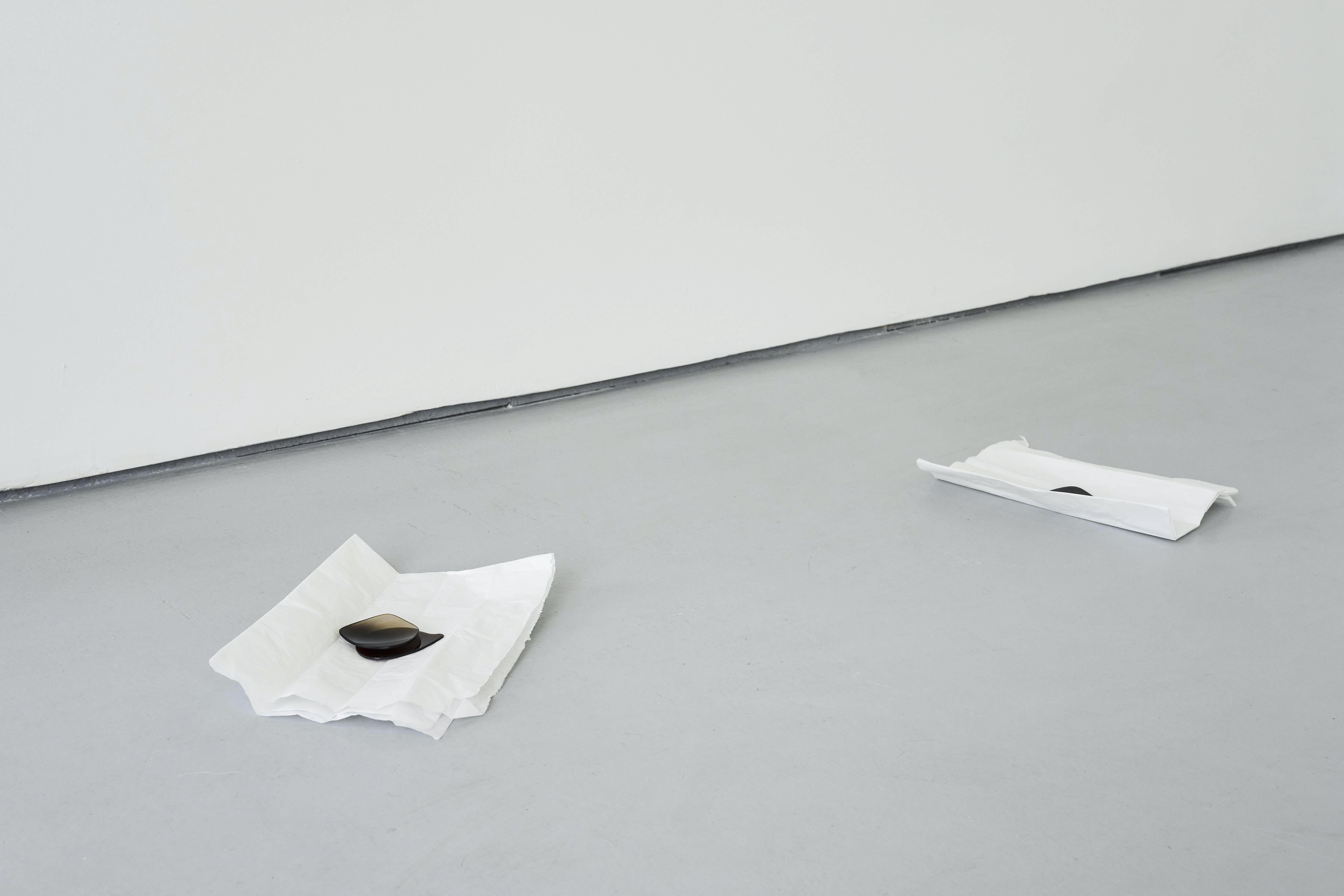
Two different lenses (...) put together (...) separate people, glasses, places, and moments — coincidence dictates they are a thing in itself now.
—Piero Bisello, 2024
—Piero Bisello, 2024

Two different lenses (...) put together (...) separate people, glasses, places, and moments — coincidence dictates they are a thing in itself now.
—Piero Bisello, 2024
—Piero Bisello, 2024
Lost at 5-chōme-37 Jingūmae, Shibuya City, Tokyo 150-0001, Japan and Rue de l'Infante Isabelle, 1000 Bruxelles, Belgium
found left and right sunglass lenses
2023
5 x 5 x 0,5 cm

Two different lenses (...) put together (...) separate people, glasses, places, and moments — coincidence dictates they are a thing in itself now.
—Piero Bisello, 2024
—Piero Bisello, 2024
Lost at Place de la Constitution, 1060 Saint-Gilles, Brussels, Belgium and Jongkindstraat, 3015 CG, Rotterdam, The Netherlands
found left and right sunglass lenses
2023
5 x 5 x 0,5 cm
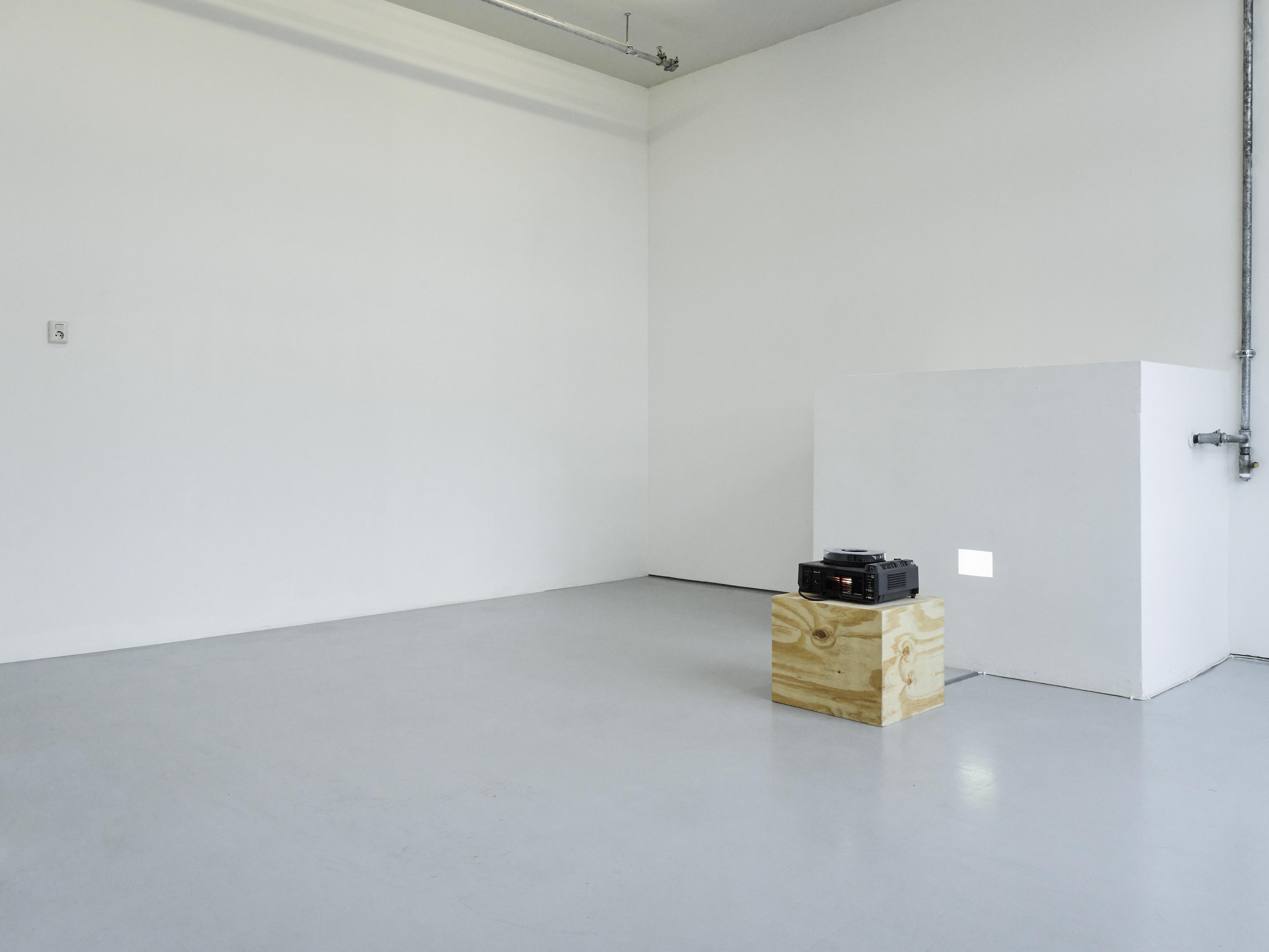
(…) slide show paced as breath projects two mouths at once: one is represented, the other one real. (…) holds the machine together, laying low, down to the ground, rather (…)
—Piero Bisello, 2024
—Piero Bisello, 2024

(…) slide show paced as breath projects two mouths at once: one is represented, the other one real. (…) holds the machine together, laying low, down to the ground, rather (…)
—Piero Bisello, 2024
—Piero Bisello, 2024

(…) slide show paced as breath projects two mouths at once: one is represented, the other one real. (…) holds the machine together, laying low, down to the ground, rather (…)
—Piero Bisello, 2024
—Piero Bisello, 2024

(…) slide show paced as breath projects two mouths at once: one is represented, the other one real. (…) holds the machine together, laying low, down to the ground, rather (…)
—Piero Bisello, 2024
—Piero Bisello, 2024

(…) slide show paced as breath projects two mouths at once: one is represented, the other one real. (…) holds the machine together, laying low, down to the ground, rather (…)
—Piero Bisello, 2024
—Piero Bisello, 2024

(…) slide show paced as breath projects two mouths at once: one is represented, the other one real. (…) holds the machine together, laying low, down to the ground, rather (…)
—Piero Bisello, 2024
—Piero Bisello, 2024

(…) slide show paced as breath projects two mouths at once: one is represented, the other one real. (…) holds the machine together, laying low, down to the ground, rather (…)
—Piero Bisello, 2024
—Piero Bisello, 2024
One and Two Mouths
20 slides of found images and 20 slides of blank film
2024
dimensions variable

(…) dead (…), presumably zoological specimens that temporarily served as true-to-life photo models. Through their particular representations, portrayed in somewhat unnaturally arranged postures, with flora and monochrome backgrounds, they give themselves away as products of culture rather than nature. (…) snakes shed their skin, a doubling displacement occurs with the postcards: the transparent lamination has coolly crawled from picture side to writing side—or, alternatively, the now-exposed snakes are revived as they abandon their own double negation.
—Timo Demollin, 2022
—Timo Demollin, 2022

(…) dead (…), presumably zoological specimens that temporarily served as true-to-life photo models. Through their particular representations, portrayed in somewhat unnaturally arranged postures, with flora and monochrome backgrounds, they give themselves away as products of culture rather than nature. (…) snakes shed their skin, a doubling displacement occurs with the postcards: the transparent lamination has coolly crawled from picture side to writing side—or, alternatively, the now-exposed snakes are revived as they abandon their own double negation.
—Timo Demollin, 2022
—Timo Demollin, 2022

(…) dead (…), presumably zoological specimens that temporarily served as true-to-life photo models. Through their particular representations, portrayed in somewhat unnaturally arranged postures, with flora and monochrome backgrounds, they give themselves away as products of culture rather than nature. (…) snakes shed their skin, a doubling displacement occurs with the postcards: the transparent lamination has coolly crawled from picture side to writing side—or, alternatively, the now-exposed snakes are revived as they abandon their own double negation.
—Timo Demollin, 2022
—Timo Demollin, 2022

(…) dead (…), presumably zoological specimens that temporarily served as true-to-life photo models. Through their particular representations, portrayed in somewhat unnaturally arranged postures, with flora and monochrome backgrounds, they give themselves away as products of culture rather than nature. (…) snakes shed their skin, a doubling displacement occurs with the postcards: the transparent lamination has coolly crawled from picture side to writing side—or, alternatively, the now-exposed snakes are revived as they abandon their own double negation.
—Timo Demollin, 2022
—Timo Demollin, 2022

(…) dead (…), presumably zoological specimens that temporarily served as true-to-life photo models. Through their particular representations, portrayed in somewhat unnaturally arranged postures, with flora and monochrome backgrounds, they give themselves away as products of culture rather than nature. (…) snakes shed their skin, a doubling displacement occurs with the postcards: the transparent lamination has coolly crawled from picture side to writing side—or, alternatively, the now-exposed snakes are revived as they abandon their own double negation.
—Timo Demollin, 2022
—Timo Demollin, 2022
Other-way-rounded as leapfrogs the face o'clock and hindmost posterior of postcard Carolina
eight postcards
2019—2022
10,5 x 14,8 cm

(…) the conventions of blazon: a type of catalog verse in which the poet lists the physical attributes of a (usually female) subject (…) strains the relation between the subject and her metaphorical body (…) re-organizing the poem, he proposes a headless subject who carries her head in her hands. We encounter the body of the text at the shoulders, after which we descend. Her head is placed in between her hands, as she touches and holds her head, and thereby her own textual representation. (…) authoring and not: he appropriates the poem (…) without taking the helm completely, thereby leaving a “headless” production with its meaning unfixed and unsettled.
—Pia Louwerens, 2023
—Pia Louwerens, 2023

(…) the conventions of blazon: a type of catalog verse in which the poet lists the physical attributes of a (usually female) subject (…) strains the relation between the subject and her metaphorical body (…) re-organizing the poem, he proposes a headless subject who carries her head in her hands. We encounter the body of the text at the shoulders, after which we descend. Her head is placed in between her hands, as she touches and holds her head, and thereby her own textual representation. (…) authoring and not: he appropriates the poem (…) without taking the helm completely, thereby leaving a “headless” production with its meaning unfixed and unsettled.
—Pia Louwerens, 2023
—Pia Louwerens, 2023
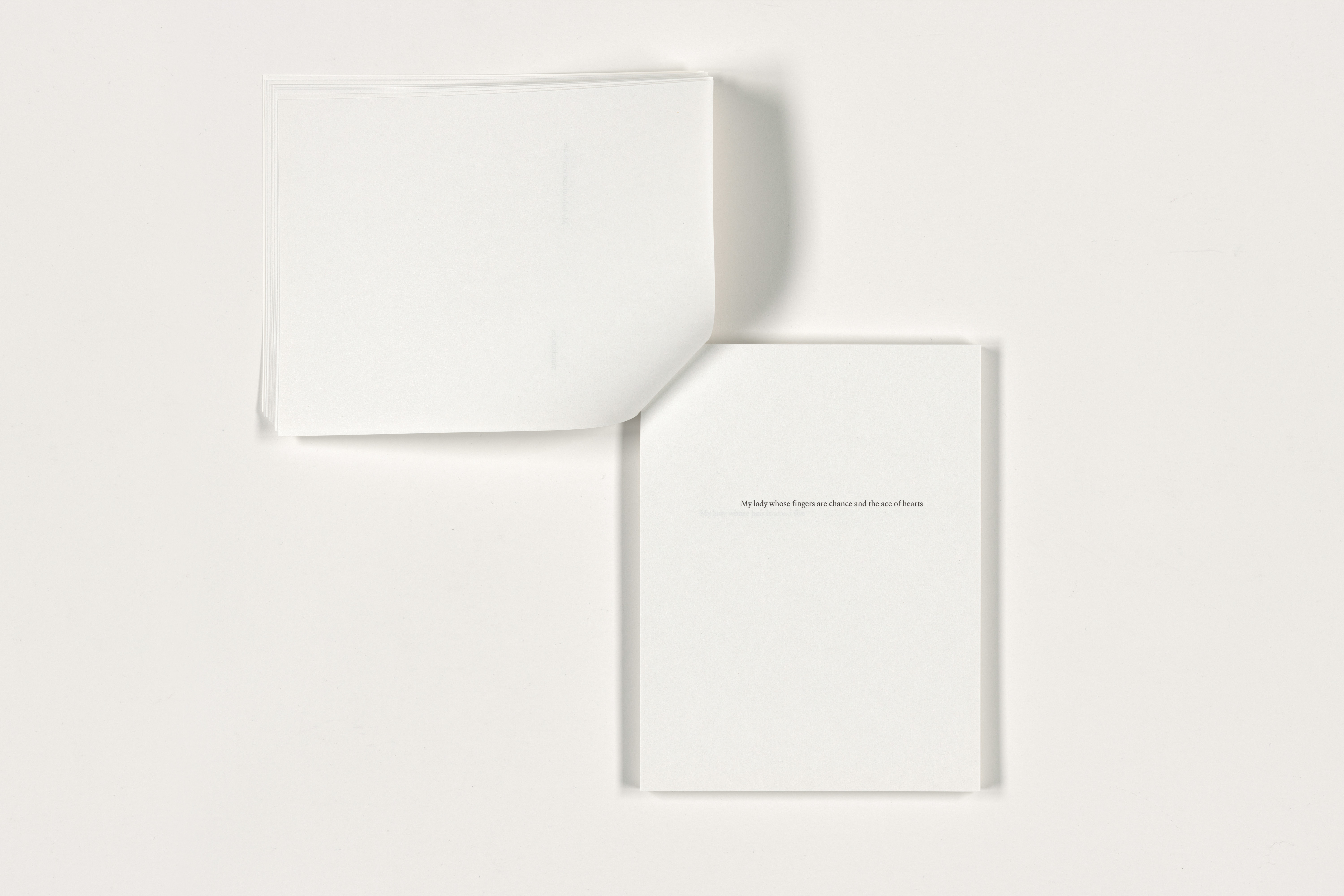
(…) the conventions of blazon: a type of catalog verse in which the poet lists the physical attributes of a (usually female) subject (…) strains the relation between the subject and her metaphorical body (…) re-organizing the poem, he proposes a headless subject who carries her head in her hands. We encounter the body of the text at the shoulders, after which we descend. Her head is placed in between her hands, as she touches and holds her head, and thereby her own textual representation. (…) authoring and not: he appropriates the poem (…) without taking the helm completely, thereby leaving a “headless” production with its meaning unfixed and unsettled.
—Pia Louwerens, 2023
—Pia Louwerens, 2023
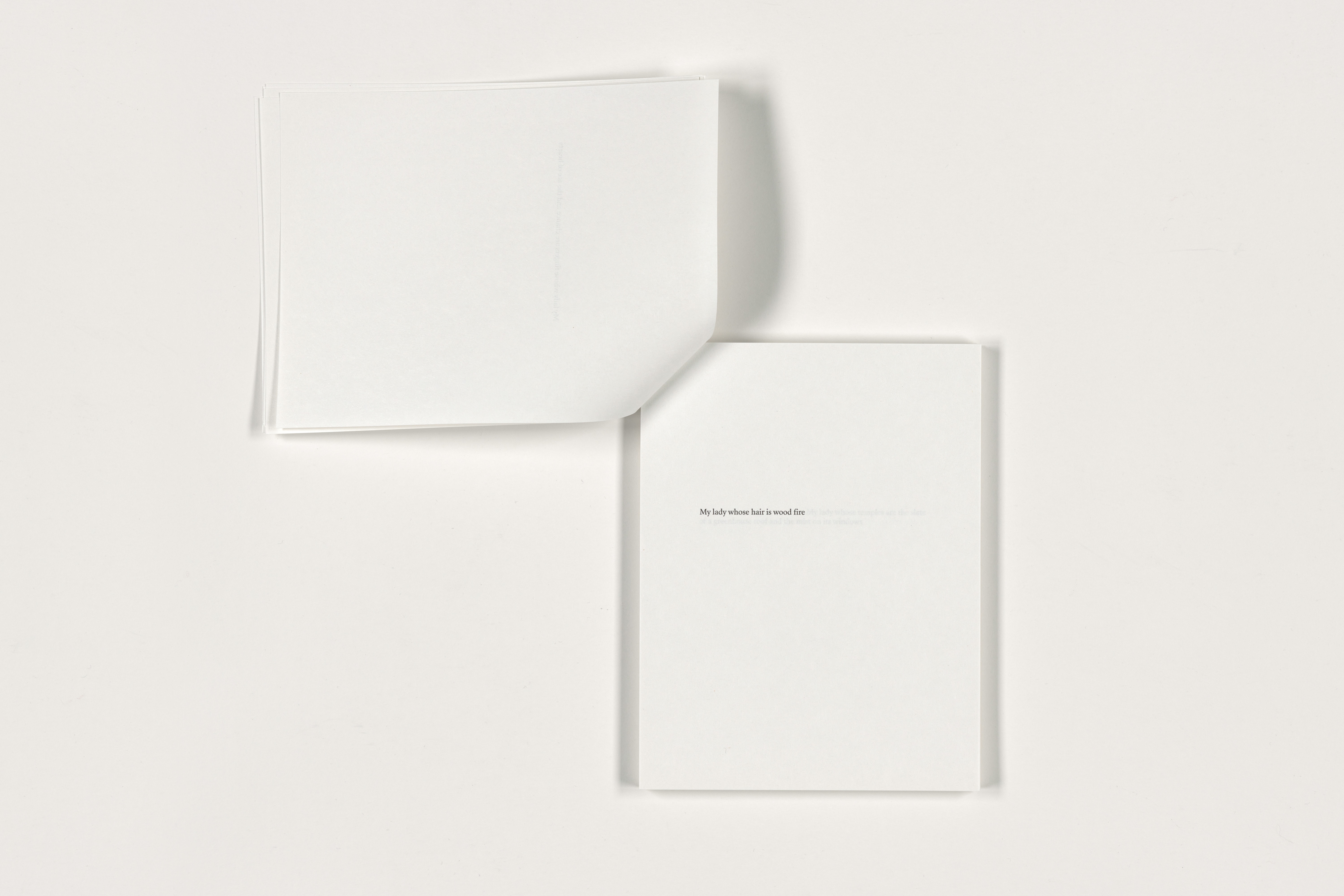
(…) the conventions of blazon: a type of catalog verse in which the poet lists the physical attributes of a (usually female) subject (…) strains the relation between the subject and her metaphorical body (…) re-organizing the poem, he proposes a headless subject who carries her head in her hands. We encounter the body of the text at the shoulders, after which we descend. Her head is placed in between her hands, as she touches and holds her head, and thereby her own textual representation. (…) authoring and not: he appropriates the poem (…) without taking the helm completely, thereby leaving a “headless” production with its meaning unfixed and unsettled.
—Pia Louwerens, 2023
—Pia Louwerens, 2023

(…) the conventions of blazon: a type of catalog verse in which the poet lists the physical attributes of a (usually female) subject (…) strains the relation between the subject and her metaphorical body (…) re-organizing the poem, he proposes a headless subject who carries her head in her hands. We encounter the body of the text at the shoulders, after which we descend. Her head is placed in between her hands, as she touches and holds her head, and thereby her own textual representation. (…) authoring and not: he appropriates the poem (…) without taking the helm completely, thereby leaving a “headless” production with its meaning unfixed and unsettled.
—Pia Louwerens, 2023
—Pia Louwerens, 2023

(…) the conventions of blazon: a type of catalog verse in which the poet lists the physical attributes of a (usually female) subject (…) strains the relation between the subject and her metaphorical body (…) re-organizing the poem, he proposes a headless subject who carries her head in her hands. We encounter the body of the text at the shoulders, after which we descend. Her head is placed in between her hands, as she touches and holds her head, and thereby her own textual representation. (…) authoring and not: he appropriates the poem (…) without taking the helm completely, thereby leaving a “headless” production with its meaning unfixed and unsettled.
—Pia Louwerens, 2023
—Pia Louwerens, 2023

(…) the conventions of blazon: a type of catalog verse in which the poet lists the physical attributes of a (usually female) subject (…) strains the relation between the subject and her metaphorical body (…) re-organizing the poem, he proposes a headless subject who carries her head in her hands. We encounter the body of the text at the shoulders, after which we descend. Her head is placed in between her hands, as she touches and holds her head, and thereby her own textual representation. (…) authoring and not: he appropriates the poem (…) without taking the helm completely, thereby leaving a “headless” production with its meaning unfixed and unsettled.
—Pia Louwerens, 2023
—Pia Louwerens, 2023
Descending Catalogue
a rearrangement of the poem L'Union libre (1931) by André Breton
artist book
2022
21 x 16 cm, 57 pages (colour & b/w ill.)

For his contribution (…) inspired by the novel Immortality (1990) by Milan Kundera (…) Vrancken brings into play notions of similarity and dissimilarity (…) It consists of two books on hand gestures, one Dutch, the other Japanese, which have been dovetailed into one another by interleaving the pages. (…) suggests that a gesture shared by different cultures, although formally similar, is sometimes used to convey an entirely different message. (…) the experience of being human carries in it more meaning than can be housed in a single body.
—Nadia de Vries, 2022
—Nadia de Vries, 2022

For his contribution (…) inspired by the novel Immortality (1990) by Milan Kundera (…) Vrancken brings into play notions of similarity and dissimilarity (…) It consists of two books on hand gestures, one Dutch, the other Japanese, which have been dovetailed into one another by interleaving the pages. (…) suggests that a gesture shared by different cultures, although formally similar, is sometimes used to convey an entirely different message. (…) the experience of being human carries in it more meaning than can be housed in a single body.
—Nadia de Vries, 2022
—Nadia de Vries, 2022

For his contribution (…) inspired by the novel Immortality (1990) by Milan Kundera (…) Vrancken brings into play notions of similarity and dissimilarity (…) It consists of two books on hand gestures, one Dutch, the other Japanese, which have been dovetailed into one another by interleaving the pages. (…) suggests that a gesture shared by different cultures, although formally similar, is sometimes used to convey an entirely different message. (…) the experience of being human carries in it more meaning than can be housed in a single body.
—Nadia de Vries, 2022
—Nadia de Vries, 2022
toe of Men
NEDERLANDS GEBARENBOEKJE interleaved with 70 Japanese Gestures
2022
20 x 41 x 2 cm

(…) Given such conceptual affinity, it is no wonder that Vrancken was surprised that the Stedelijk Museum Schiedam had a table (with the dimensions 3 x 7.5 x 1.5 sb-feet) made to present a work by brouwn, but had passed it down to the rental company Museumgoed as a functional object after the exhibition. The question raised by this act is where brouwn's work begins and ends. Is it conceptually justifiable to include one object in the collection as a work of art but to reduce its counterpart to utility object despite their shared conditions?
—Manus Groenen, 2021
—Manus Groenen, 2021
Untitled
disassembled stanley brouwn table
2021
3 x 7.5 x 1.5 sb-foot

(…) a limited edition mail-out dispatched prior to the exhibition. The project space is named as an homage to the artists and founders Tim Mathijsen and Tirza Kater's friend, Marwan, who left Amsterdam. (…) He employs the marketing and communicating tools of Marwan, and transforms the hosting initiative's narrow flyer into a concert wrist band. (…) it can twice encircle his wrist, or by extension, once around Tim's and Tirza's - the sum of Marwan - as well. (…) Once the band is unfolded, the information is undecipherable from fragments which are made only to be legible in its folded form.
—Christina Li, 2021
—Christina Li, 2021

(…) a limited edition mail-out dispatched prior to the exhibition. The project space is named as an homage to the artists and founders Tim Mathijsen and Tirza Kater's friend, Marwan, who left Amsterdam. (…) He employs the marketing and communicating tools of Marwan, and transforms the hosting initiative's narrow flyer into a concert wrist band. (…) it can twice encircle his wrist, or by extension, once around Tim's and Tirza's - the sum of Marwan - as well. (…) Once the band is unfolded, the information is undecipherable from fragments which are made only to be legible in its folded form.
—Christina Li, 2021
—Christina Li, 2021

(…) a limited edition mail-out dispatched prior to the exhibition. The project space is named as an homage to the artists and founders Tim Mathijsen and Tirza Kater's friend, Marwan, who left Amsterdam. (…) He employs the marketing and communicating tools of Marwan, and transforms the hosting initiative's narrow flyer into a concert wrist band. (…) it can twice encircle his wrist, or by extension, once around Tim's and Tirza's - the sum of Marwan - as well. (…) Once the band is unfolded, the information is undecipherable from fragments which are made only to be legible in its folded form.
—Christina Li, 2021
—Christina Li, 2021
Invitation for Marwan
folded digital print
2021
39,5 x 3,5 cm (unfolded)
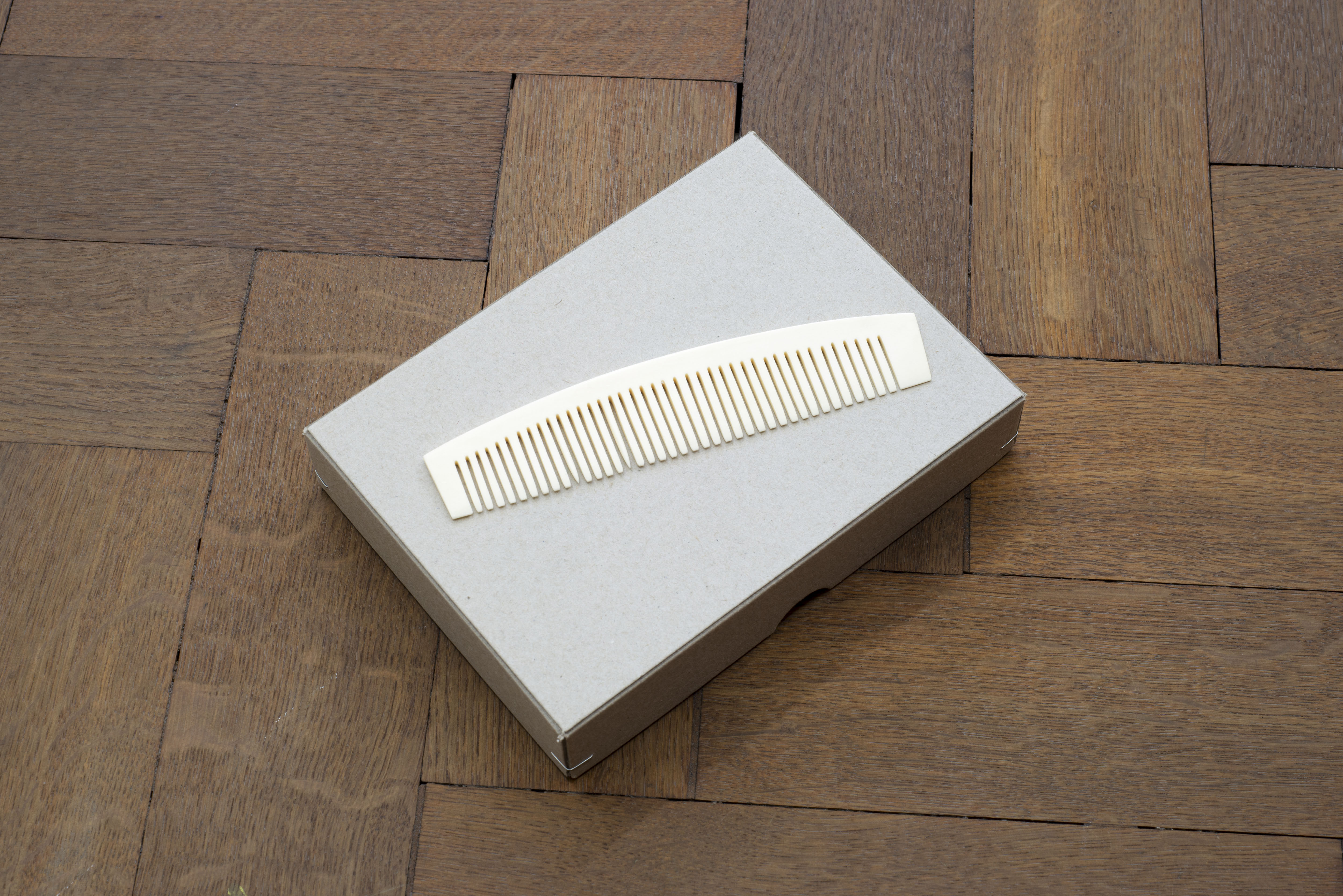
(…) a bone comb with two teeth sharpened to points. The work alludes to the many versions of the myth surrounding Cleopatra's alleged suicide. (…) about how leaving a snakebite on your body, real or fake, is a guarantee to a next life. The comb negates the image that the title suggests. We don't see a dew covered flower at all. (…) Vrancken is not only invested in the meanings to which he wants to refer, but also with how he wants to refer to them. Flower, dew (2021) is a complex dance in which Reinier challenges us to search for meanings in all layers of the work.
—Linda Köke, 2021
—Linda Köke, 2021

(…) a bone comb with two teeth sharpened to points. The work alludes to the many versions of the myth surrounding Cleopatra's alleged suicide. (…) about how leaving a snakebite on your body, real or fake, is a guarantee to a next life. The comb negates the image that the title suggests. We don't see a dew covered flower at all. (…) Vrancken is not only invested in the meanings to which he wants to refer, but also with how he wants to refer to them. Flower, dew (2021) is a complex dance in which Reinier challenges us to search for meanings in all layers of the work.
—Linda Köke, 2021
—Linda Köke, 2021

(…) a bone comb with two teeth sharpened to points. The work alludes to the many versions of the myth surrounding Cleopatra's alleged suicide. (…) about how leaving a snakebite on your body, real or fake, is a guarantee to a next life. The comb negates the image that the title suggests. We don't see a dew covered flower at all. (…) Vrancken is not only invested in the meanings to which he wants to refer, but also with how he wants to refer to them. Flower, dew (2021) is a complex dance in which Reinier challenges us to search for meanings in all layers of the work.
—Linda Köke, 2021
—Linda Köke, 2021

(…) a bone comb with two teeth sharpened to points. The work alludes to the many versions of the myth surrounding Cleopatra's alleged suicide. (…) about how leaving a snakebite on your body, real or fake, is a guarantee to a next life. The comb negates the image that the title suggests. We don't see a dew covered flower at all. (…) Vrancken is not only invested in the meanings to which he wants to refer, but also with how he wants to refer to them. Flower, dew (2021) is a complex dance in which Reinier challenges us to search for meanings in all layers of the work.
—Linda Köke, 2021
—Linda Köke, 2021
Flower, dew
two sharpened teeth on a comb
2021
15 x 3,2 x 0,5 cm
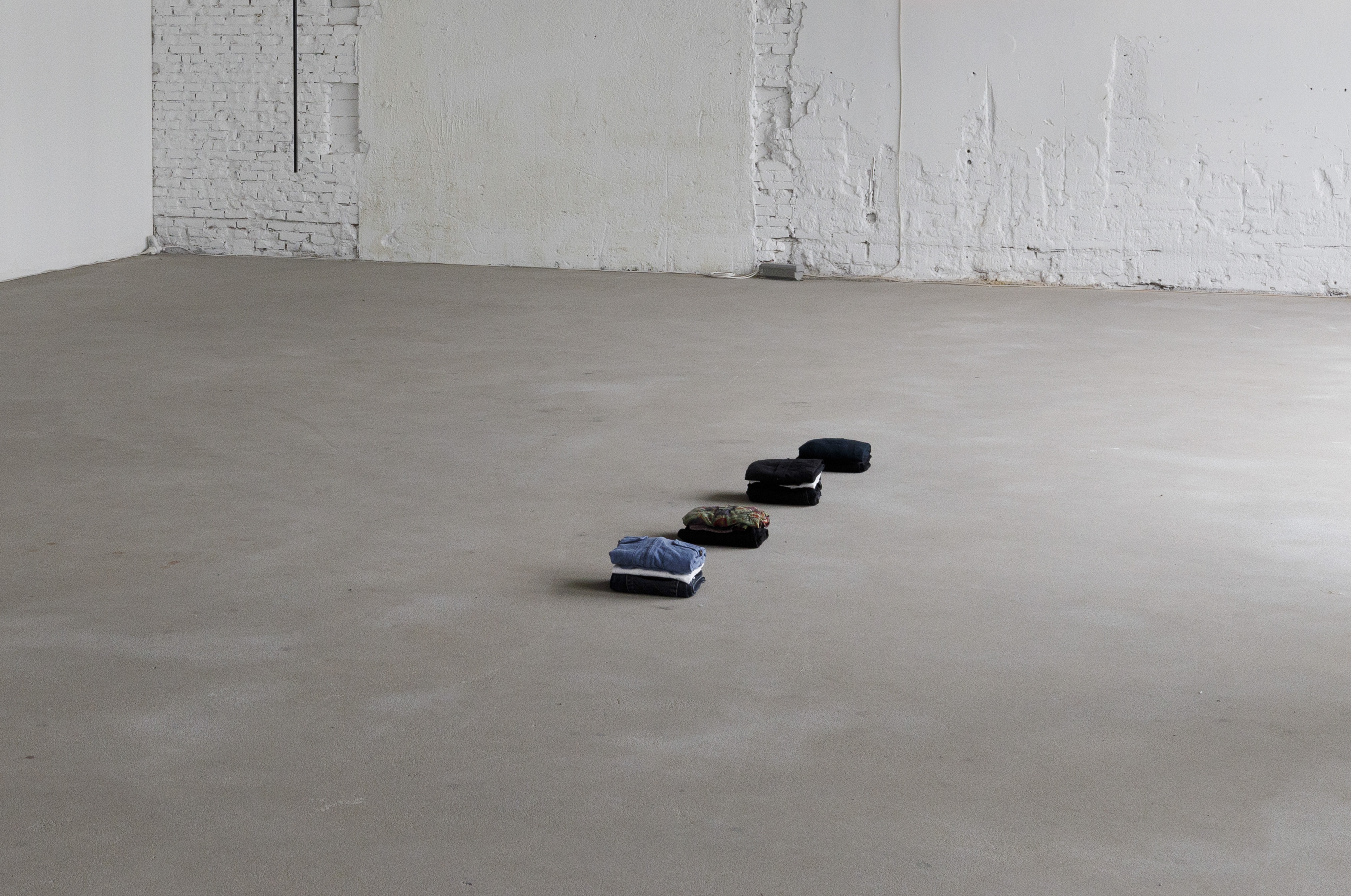
(…) is part of an ongoing work in series. The piles of clothing on the floor are on loan. Each pile carries a smell other than its owner's. Emma's smell is in the pile to the left, and her clothes are in the pile to the right. Identity shifts, but only half a place. Every outfit is passed to another individual to be washed, who in turn lends out his or hers, establishing a chain of passed-on clothing and changing smells. A relay of appropriation and expropriation. In Everybody becoming everybody else, Vrancken redefines the borders between one individual and the other. In doing so, he creates the opportunity to propose new wholes. (…) are always strangers to one another, who (…) have the silhouetted Vrancken as their common factor.
—Machteld Leij, 2021
—Machteld Leij, 2021
Everybody and everybody else
Isabel's clothes and Rabin's smell
2020
25 x 20 x 15 cm
Everybody and everybody else
Rabin's clothes and Manus' smell
2020
25 x 20 x 15 cm
Everybody and everybody else
Manus' clothes and Louise's smell
2020
25 x 20 x 15 cm
Everybody and everybody else
Louise's clothes and Bernadette's smell
2020
25 x 20 x 15 cm
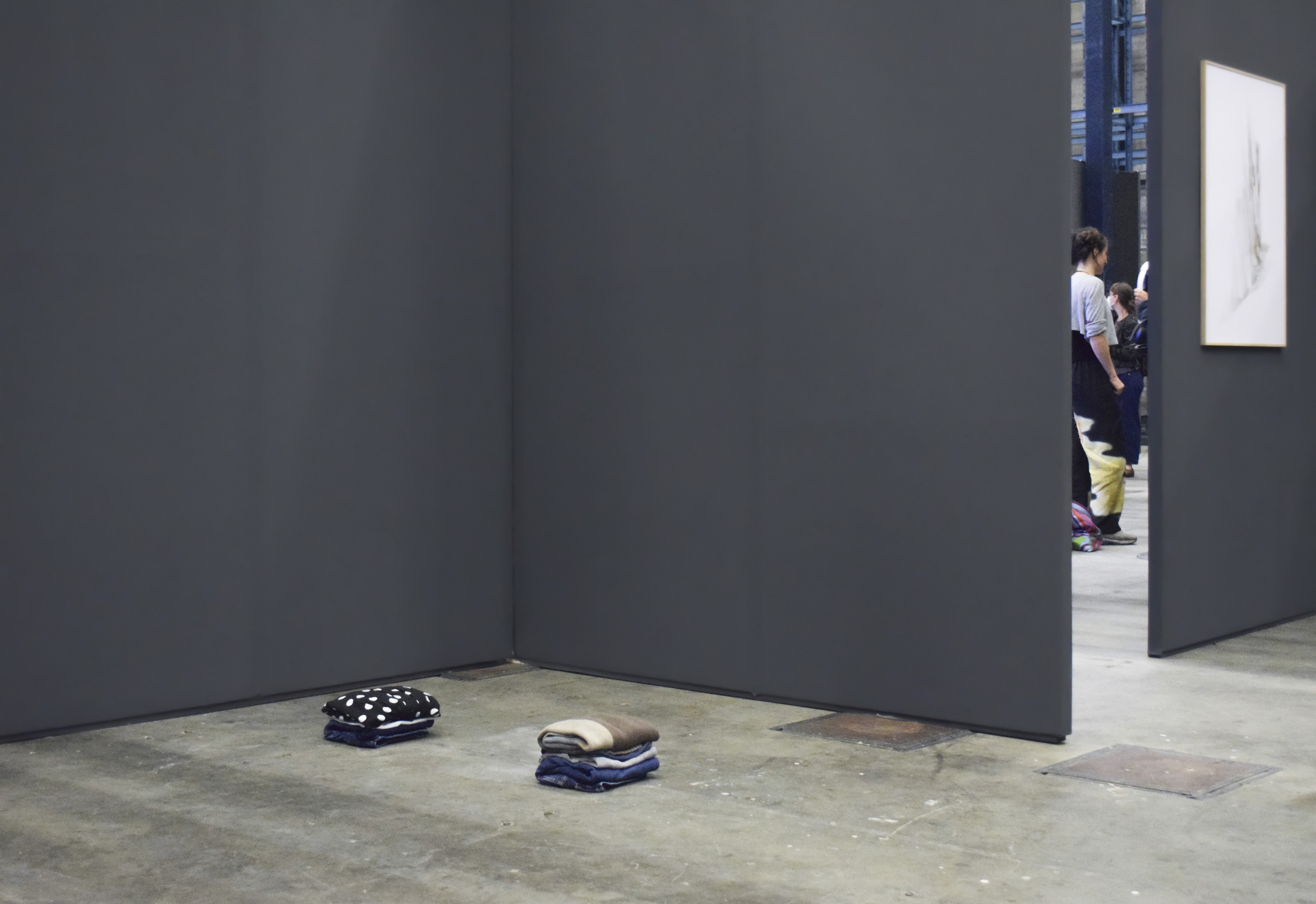
(…) is part of an ongoing work in series. The piles of clothing on the floor are on loan. Each pile carries a smell other than its owner's. Emma's smell is in the pile to the left, and her clothes are in the pile to the right. Identity shifts, but only half a place. Every outfit is passed to another individual to be washed, who in turn lends out his or hers, establishing a chain of passed-on clothing and changing smells. A relay of appropriation and expropriation. In Everybody becoming everybody else, Vrancken redefines the borders between one individual and the other. In doing so, he creates the opportunity to propose new wholes. (…) are always strangers to one another, who (…) have the silhouetted Vrancken as their common factor.
—Machteld Leij, 2021
—Machteld Leij, 2021
Everybody and everybody else
Bernadette's clothes and Sander's smell
2021
25 x 20 x 15 cm
Everybody and everybody else
Sander's clothes and Matt's smell
2021
25 x 20 x 15 cm

(…) is part of an ongoing work in series. The piles of clothing on the floor are on loan. Each pile carries a smell other than its owner's. Emma's smell is in the pile to the left, and her clothes are in the pile to the right. Identity shifts, but only half a place. Every outfit is passed to another individual to be washed, who in turn lends out his or hers, establishing a chain of passed-on clothing and changing smells. A relay of appropriation and expropriation. In Everybody becoming everybody else, Vrancken redefines the borders between one individual and the other. In doing so, he creates the opportunity to propose new wholes. (…) are always strangers to one another, who (…) have the silhouetted Vrancken as their common factor.
—Machteld Leij, 2021
—Machteld Leij, 2021
Everybody and everybody else
Matt's clothes and Rudi's smell
2021
25 x 20 x 15 cm
Everybody and everybody else
Rudi's clothes and Sarah's smell
2021
25 x 20 x 15 cm
Everybody and everybody else
Sarah's clothes and Rob's smell
2021
25 x 20 x 15 cm

(…) is part of an ongoing work in series. The piles of clothing on the floor are on loan. Each pile carries a smell other than its owner's. Emma's smell is in the pile to the left, and her clothes are in the pile to the right. Identity shifts, but only half a place. Every outfit is passed to another individual to be washed, who in turn lends out his or hers, establishing a chain of passed-on clothing and changing smells. A relay of appropriation and expropriation. In Everybody becoming everybody else, Vrancken redefines the borders between one individual and the other. In doing so, he creates the opportunity to propose new wholes. (…) are always strangers to one another, who (…) have the silhouetted Vrancken as their common factor.
—Machteld Leij, 2021
—Machteld Leij, 2021
Everybody and everybody else
Rob's clothes and Emma's smell
2021
25 x 20 x 15 cm
Everybody and everybody else
Emma's clothes and Machteld's smell
2021
25 x 20 x 15 cm

(…) is part of an ongoing work in series. The piles of clothing on the floor are on loan. Each pile carries a smell other than its owner's. Emma's smell is in the pile to the left, and her clothes are in the pile to the right. Identity shifts, but only half a place. Every outfit is passed to another individual to be washed, who in turn lends out his or hers, establishing a chain of passed-on clothing and changing smells. A relay of appropriation and expropriation. In Everybody becoming everybody else, Vrancken redefines the borders between one individual and the other. In doing so, he creates the opportunity to propose new wholes. (…) are always strangers to one another, who (…) have the silhouetted Vrancken as their common factor.
—Machteld Leij, 2021
—Machteld Leij, 2021
Everybody and everybody else
Machteld's clothes and Émile's smell
2022
25 x 20 x 15 cm
Everybody and everybody else
Émile's clothes and Marjolein's smell
2022
25 x 20 x 15 cm

(…) Vrancken's works are propositions to interpret the amalgamation of conceptual, semantic and poetic leaps and conceptions that are ascribed to seemingly autonomous objects and words around us. (…) The title is borrowed from the final line of Thomas James' poem Room 101 whereby the protagonist narrates how he is slowly turned to stone. Notions of preservation and transfiguration are pushed further when the title is juxtaposed with what is on display: different bottled fluids Vrancken obtained after working with a professional embalmer. (…) the look and feel of marble.
—Christina Li, 2021
—Christina Li, 2021

(…) Vrancken's works are propositions to interpret the amalgamation of conceptual, semantic and poetic leaps and conceptions that are ascribed to seemingly autonomous objects and words around us. (…) The title is borrowed from the final line of Thomas James' poem Room 101 whereby the protagonist narrates how he is slowly turned to stone. Notions of preservation and transfiguration are pushed further when the title is juxtaposed with what is on display: different bottled fluids Vrancken obtained after working with a professional embalmer. (…) the look and feel of marble.
—Christina Li, 2021
—Christina Li, 2021

(…) Vrancken's works are propositions to interpret the amalgamation of conceptual, semantic and poetic leaps and conceptions that are ascribed to seemingly autonomous objects and words around us. (…) The title is borrowed from the final line of Thomas James' poem Room 101 whereby the protagonist narrates how he is slowly turned to stone. Notions of preservation and transfiguration are pushed further when the title is juxtaposed with what is on display: different bottled fluids Vrancken obtained after working with a professional embalmer. (…) the look and feel of marble.
—Christina Li, 2021
—Christina Li, 2021
A hornet tests my sculptured skin
embalming formula composed to give the appearance of marble
2021
dimensions variable

(…) proposed to annotate Shimmer's website with (…) a translation between words starting at opposite ends of the alphabet. The word accessible, located on the About page on Shimmer's website, translates to züganglich. (…) We found his intervention interesting, particularly as it becomes our only permanent work that will adapt or even disappear if we remove the word that Reinier annotates.
—Eloise Sweetman and Jason Hendrik Hansma, 2020
—Eloise Sweetman and Jason Hendrik Hansma, 2020

(…) proposed to annotate Shimmer's website with (…) a translation between words starting at opposite ends of the alphabet. The word accessible, located on the About page on Shimmer's website, translates to züganglich. (…) We found his intervention interesting, particularly as it becomes our only permanent work that will adapt or even disappear if we remove the word that Reinier annotates.
—Eloise Sweetman and Jason Hendrik Hansma, 2020
—Eloise Sweetman and Jason Hendrik Hansma, 2020
A translation between words starting at opposite ends of the alphabet
transparent page (Ibo One, 60g)
2021
Prospects, Mondriaanfund, colour & b/w ill., 17 x 12 cm, 175 pages

(…) proposed to annotate Shimmer's website with (…) a translation between words starting at opposite ends of the alphabet. The word accessible, located on the About page on Shimmer's website, translates to züganglich. (…) We found his intervention interesting, particularly as it becomes our only permanent work that will adapt or even disappear if we remove the word that Reinier annotates.
—Eloise Sweetman and Jason Hendrik Hansma, 2020
—Eloise Sweetman and Jason Hendrik Hansma, 2020

(…) proposed to annotate Shimmer's website with (…) a translation between words starting at opposite ends of the alphabet. The word accessible, located on the About page on Shimmer's website, translates to züganglich. (…) We found his intervention interesting, particularly as it becomes our only permanent work that will adapt or even disappear if we remove the word that Reinier annotates.
—Eloise Sweetman and Jason Hendrik Hansma, 2020
—Eloise Sweetman and Jason Hendrik Hansma, 2020
A translation between words starting at opposite ends of the alphabet
transparent insert (tracing paper, 90g)
2021
DU 2020, DU, colour & b/w ill., 24 x 17 cm, 92 pages

(…) proposed to annotate Shimmer's website with (…) a translation between words starting at opposite ends of the alphabet. The word accessible, located on the About page on Shimmer's website, translates to züganglich. (…) We found his intervention interesting, particularly as it becomes our only permanent work that will adapt or even disappear if we remove the word that Reinier annotates.
—Eloise Sweetman and Jason Hendrik Hansma, 2020
—Eloise Sweetman and Jason Hendrik Hansma, 2020
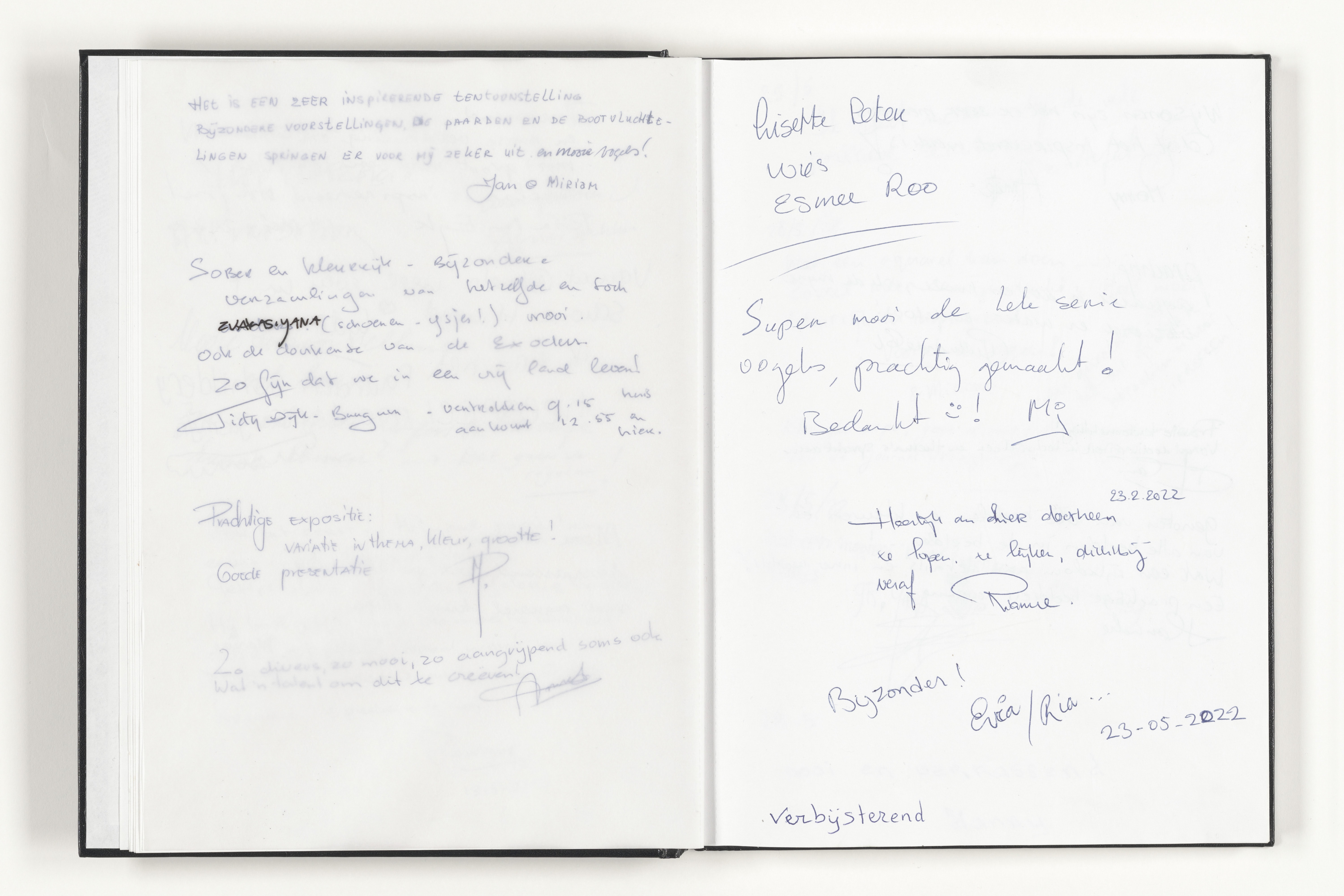
(…) proposed to annotate Shimmer's website with (…) a translation between words starting at opposite ends of the alphabet. The word accessible, located on the About page on Shimmer's website, translates to züganglich. (…) We found his intervention interesting, particularly as it becomes our only permanent work that will adapt or even disappear if we remove the word that Reinier annotates.
—Eloise Sweetman and Jason Hendrik Hansma, 2020
—Eloise Sweetman and Jason Hendrik Hansma, 2020
A translation between words starting at opposite ends of the alphabet
transparent page (tracing paper, 90g)
2022
guestbook, De Cacaofabriek, 29,7 x 21 cm, 100 pages

(…) a stained glass window in the monumental stairwell, where the story of Saint Martin is depicted. (…) Vrancken deliberately chose not to add anything to the space, but to simply rearrange an existing element. On the handrail in the stairwell there are three attachments that had raised the height of the railing. Vrancken's intervention brings them back to the railing's original height (…) the corrections were not only out of place in terms of aesthetics, but also disrupted the movement that the stair and railing jointly orchestrated. Because the railing suddenly jumped a decimeter in certain places, one had to adjust his or her grip and movements while walking the stairs. (…) By lowering the extension of the balustrade and placing it next to the existing one, it doubles in form without doubling it in function. (…) I still look up at the window, through which the sun shines on the cloak of Saint Martin, split in two.
—Linda Köke, 2019
—Linda Köke, 2019

(…) a stained glass window in the monumental stairwell, where the story of Saint Martin is depicted. (…) Vrancken deliberately chose not to add anything to the space, but to simply rearrange an existing element. On the handrail in the stairwell there are three attachments that had raised the height of the railing. Vrancken's intervention brings them back to the railing's original height (…) the corrections were not only out of place in terms of aesthetics, but also disrupted the movement that the stair and railing jointly orchestrated. Because the railing suddenly jumped a decimeter in certain places, one had to adjust his or her grip and movements while walking the stairs. (…) By lowering the extension of the balustrade and placing it next to the existing one, it doubles in form without doubling in function. (…) I still look up at the window, through which the sun shines on the cloak of Saint Martin, split in two.
—Linda Köke, 2019
—Linda Köke, 2019
De misgrijpers
lowered handrail extensions
2019
dimensions variable

(…) screenshots (…) show a website's attempt to determine in which letter Lawrence Weiner's text-installation was typeset. The website interprets images to separate letters and to store them into compartments. In one compartment, Lawrence (…) casually leans on one boot, characterised as a letter. (…) multiple meanings (…) As long as he occupies the compartment, your alphabet's sixth letter is absent. In Weiner's presence, Vrancken uses words in which this compartment is skipped (…)
—Brenda Tempelaar, 2019
—Brenda Tempelaar, 2019

(…) screenshots (…) show a website's attempt to determine in which letter Lawrence Weiner's text-installation was typeset. The website interprets images to separate letters and to store them into compartments. In one compartment, Lawrence (…) casually leans on one boot, characterised as a letter. (…) multiple meanings (…) As long as he occupies the compartment, your alphabet's sixth letter is absent. In Weiner's presence, Vrancken uses words in which this compartment is skipped (…)
—Brenda Tempelaar, 2019
—Brenda Tempelaar, 2019

(…) screenshots (…) show a website's attempt to determine in which letter Lawrence Weiner's text-installation was typeset. The website interprets images to separate letters and to store them into compartments. In one compartment, Lawrence (…) casually leans on one boot, characterised as a letter. (…) multiple meanings (…) As long as he occupies the compartment, your alphabet's sixth letter is absent. In Weiner's presence, Vrancken uses words in which this compartment is skipped (…)
—Brenda Tempelaar, 2019
—Brenda Tempelaar, 2019

(…) screenshots (…) show a website's attempt to determine in which letter Lawrence Weiner's text-installation was typeset. The website interprets images to separate letters and to store them into compartments. In one compartment, Lawrence (…) casually leans on one boot, characterised as a letter. (…) multiple meanings (…) As long as he occupies the compartment, your alphabet's sixth letter is absent. In Weiner's presence, Vrancken uses words in which this compartment is skipped (…)
—Brenda Tempelaar, 2019
—Brenda Tempelaar, 2019
Axeman Jacob unwizardly trips over knee-high sequoia
artist book
2019
colour & b/w ill., 22 x 15,5 cm, 11 pages

(…) an adder, that uses a mountain's image as its title. Slithering along this mountain is a stretched cloud. (…) this image occupies a space usually inhabited by letters. Like a vowel can be pronounced in several ways—a, aa—, this work can be pronounced as a cloud or as an adder.
—Brenda Tempelaar, 2019
—Brenda Tempelaar, 2019

(…) an adder, that uses a mountain's image as its title. Slithering along this mountain is a stretched cloud. (…) this image occupies a space usually inhabited by letters. Like a vowel can be pronounced in several ways—a, aa—, this work can be pronounced as a cloud or as an adder.
—Brenda Tempelaar, 2019
—Brenda Tempelaar, 2019

(…) an adder, that uses a mountain's image as its title. Slithering along this mountain is a stretched cloud. (…) this image occupies a space usually inhabited by letters. Like a vowel can be pronounced in several ways—a, aa—, this work can be pronounced as a cloud or as an adder.
—Brenda Tempelaar, 2019
—Brenda Tempelaar, 2019

(…) an adder, that uses a mountain's image as its title. Slithering along this mountain is a stretched cloud. (…) this image occupies a space usually inhabited by letters. Like a vowel can be pronounced in several ways—a, aa—, this work can be pronounced as a cloud or as an adder.
—Brenda Tempelaar, 2019
—Brenda Tempelaar, 2019
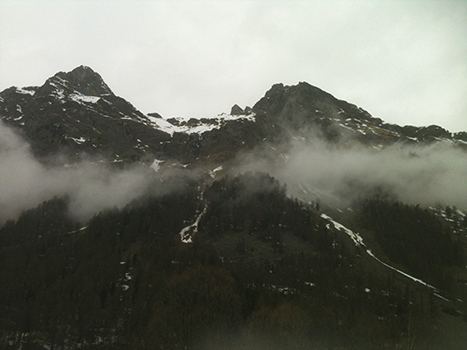 2018—2020
dimensions variable
2018—2020
dimensions variable

(…) In the work titled Participating in the exhibition as Raniero, Vrancken embraced this dilution in language and participated as Raniero in an exhibition: a name that appeared on all press releases, publications and posters (…) It is a semiotic game that Vrancken often plays to rearrange the forces at work between signified and signifier.
—Manus Groenen, 2022
—Manus Groenen, 2022
Participating in the exhibition as Raniero
poster, flyer, advertisements, invitation, press-release, window lettering
2018
dimensions variable

Sitting on a chair, legs crossed (…) Reader's Digest open in his lap, he reads. At specific moments in the performance, he sips from the glass of water on the table beside him. Ader marked 26 moments in the text at which he would drink his water. In Te lezen vallen, Vrancken used correction fluid to remove all except for the notations from a copy of Bas Jan's original Reader's Digest. The text ends up in a liminal space between reading and seeing. (…) crosses (…) x's (…) Falling (…) fall (…) fall (…)
—Manus Groenen, 2022
—Manus Groenen, 2022

Sitting on a chair, legs crossed (…) Reader's Digest open in his lap, he reads. At specific moments in the performance, he sips from the glass of water on the table beside him. Ader marked 26 moments in the text at which he would drink his water. In Te lezen vallen, Vrancken used correction fluid to remove all except for the notations from a copy of Bas Jan's original Reader's Digest. The text ends up in a liminal space between reading and seeing. (…) crosses (…) x's (…) Falling (…) fall (…) fall (…)
—Manus Groenen, 2022
—Manus Groenen, 2022

Sitting on a chair, legs crossed (…) Reader's Digest open in his lap, he reads. At specific moments in the performance, he sips from the glass of water on the table beside him. Ader marked 26 moments in the text at which he would drink his water. In Te lezen vallen, Vrancken used correction fluid to remove all except for the notations from a copy of Bas Jan's original Reader's Digest. The text ends up in a liminal space between reading and seeing. (…) crosses (…) x's (…) Falling (…) fall (…) fall (…)
—Manus Groenen, 2022
—Manus Groenen, 2022

Sitting on a chair, legs crossed (…) Reader's Digest open in his lap, he reads. At specific moments in the performance, he sips from the glass of water on the table beside him. Ader marked 26 moments in the text at which he would drink his water. In Te lezen vallen, Vrancken used correction fluid to remove all except for the notations from a copy of Bas Jan's original Reader's Digest. The text ends up in a liminal space between reading and seeing. (…) crosses (…) x's (…) Falling (…) fall (…) fall (…)
—Manus Groenen, 2022
—Manus Groenen, 2022

Sitting on a chair, legs crossed (…) Reader's Digest open in his lap, he reads. At specific moments in the performance, he sips from the glass of water on the table beside him. Ader marked 26 moments in the text at which he would drink his water. In Te lezen vallen, Vrancken used correction fluid to remove all except for the notations from a copy of Bas Jan's original Reader's Digest. The text ends up in a liminal space between reading and seeing. (…) crosses (…) x's (…) Falling (…) fall (…) fall (…)
—Manus Groenen, 2022
—Manus Groenen, 2022

Sitting on a chair, legs crossed (…) Reader's Digest open in his lap, he reads. At specific moments in the performance, he sips from the glass of water on the table beside him. Ader marked 26 moments in the text at which he would drink his water. In Te lezen vallen, Vrancken used correction fluid to remove all except for the notations from a copy of Bas Jan's original Reader's Digest. The text ends up in a liminal space between reading and seeing. (…) crosses (…) x's (…) Falling (…) fall (…) fall (…)
—Manus Groenen, 2022
—Manus Groenen, 2022
Te lezen vallen
Bas Jan Ader's marks in The Boy Who Plunged Over Niagara (Lawrence Elliott, 1962)
photocopy, correction fluid
2019
3x 29,7 x 21 cm
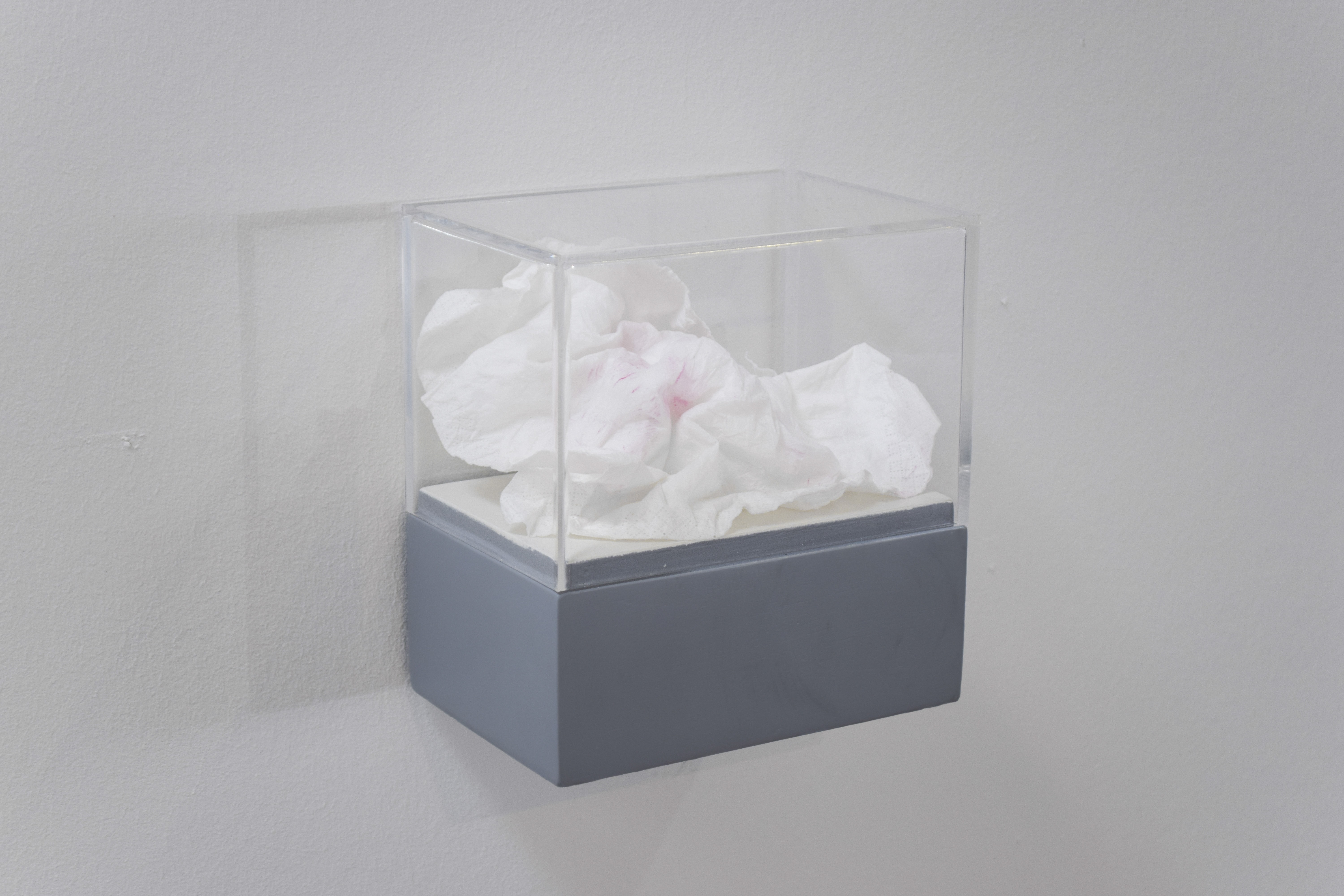
(…) With this pictorial title, Vrancken suggests that he partially stole Bowie, who, as a consequence, comminuted to stardust. (…) A similar tissue was exhibited in the traveling exhibition David Bowie Is. But perhaps Vrancken's tissue is an atonement, more than it is a tribute. The tissue reminisces the moment that Bowie and Vrancken partially coincided in meaning, but a soul was swapped too. An eye, an eye, a tooth, a tooth, is Vrancken's motto, whose exhibition instills drama in popstars, iconic artists animals and landscapes.
—Brenda Tempelaar, 2018
—Brenda Tempelaar, 2018

(…) With this pictorial title, Vrancken suggests that he partially stole Bowie, who, as a consequence, comminuted to stardust. (…) A similar tissue was exhibited in the traveling exhibition David Bowie Is. But perhaps Vrancken's tissue is an atonement, more than it is a tribute. The tissue reminisces the moment that Bowie and Vrancken partially coincided in meaning, but a soul was swapped too. An eye, an eye, a tooth, a tooth, is Vrancken's motto, whose exhibition instills drama in popstars, iconic artists animals and landscapes.
—Brenda Tempelaar, 2018
—Brenda Tempelaar, 2018

(…) With this pictorial title, Vrancken suggests that he partially stole Bowie, who, as a consequence, comminuted to stardust. (…) A similar tissue was exhibited in the traveling exhibition David Bowie Is. But perhaps Vrancken's tissue is an atonement, more than it is a tribute. The tissue reminisces the moment that Bowie and Vrancken partially coincided in meaning, but a soul was swapped too. An eye, an eye, a tooth, a tooth, is Vrancken's motto, whose exhibition instills drama in popstars, iconic artists animals and landscapes.
—Brenda Tempelaar, 2018
—Brenda Tempelaar, 2018
Where are we now?—The great gig in the sky
lipstick, tissue, wood, plexiglass
2016
20 x 15 x 10 cm